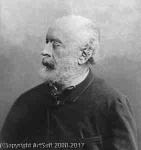Evariste Vital Luminais
Evariste Vital Luminais
Born: 1821
Death: 1896
Biography:
Évariste Vital Luminais was a French painter. He is best known for works depicting early French history and is sometimes called "the painter of the Gauls".
Luminais was born in Nantes into a parliamentary and legal family. His great-grandfather Michel Luminais was an official in the Vendée; his grandfather Michel-Pierre Luminais represented the Vendée in parliament from 1799 to 1803; and his father, René Marie Luminais, represented Loire-Inférieure from 1831 to 1834 and Indre-et-Loire from 1848 to 1849. Aware of his natural artistic talent, his family sent him to Paris when he was 18 to study with the painter and sculptor Auguste Debay. He also studied with Léon Cogniet, a historical and portrait painter whose pupils included Léon Bonnat, and Constant Troyon, who painted landscapes and animals.
He married twice. By his first wife, Anne Foiret, he had a daughter, Esther. After Anne's death in 1874, he remarried in 1876 to one of his pupils, Hélène de Sahuguet d'Amarzit d'Espagnac; she had been married to Claude Durand de Neuville but had been widowed in the War of 1870.
He made his official début at the 1843 Paris Salon, where two of his paintings were hung. He won medals at the Salons of 1852, 1855, 1857, 1861 and 1889. In 1869, he was awarded the Légion d'honneur. He won the gold medal at the 1889 Exposition, and was a founder member of the Société des Artistes Français. For more than forty years, he divided his time between his Paris studio at 17 boulevard Lannes and his summer house and studio in the village of Douadic, in the Brenne region. The area had been recommended to him by two friends, Jules de Vorys and Louis Fombelle. Among his students were Albert Maignan and Emily Sartain; he was one of the few Academy painters who would teach women.
Luminais died in Paris at the age of 75 and was buried in the little cemetery in Douadic. His native city of Nantes has a street named for him.
Luminais worked in the genre and historical modes. He was among the academic painters who satisfied a social demand for aggrandising, even propagandistic historical works in the early years of the Third Republic, after the defeat in the Franco-Prussian War. As such, he shared in their condemnation by the advocates of modern art. However, in some paintings, such as The Widow (1865) he foreshadows social realism. He also used a historical dressing to make hunting and peasant scenes more palatable to the Academy.
Luminais played an important part in disseminating the iconography of the Gauls; their popular image, with long hair and winged helmets, was developed by historians at this time as part of an examination of French history. Sometimes called 'the painter of the Gauls', he also depicted other scenes of early medieval history, often clashes between different peoples, such as campaign-hardened Romans in breastplates reinforced with metal battling daring Celts who are bare-chested, with only helmet and shield for protection.
More unusually among historical artists of the time, he also depicted the Franks, whose contribution to French history was then generally underrated in favour of the Gauls. His painting of the Alemannic rout at the hands of the Franks in the Battle of Tolbiac impressed Théophile Gautier at the 1848 Salon. His Frankish Cavalry in Combat was inspired by reading Chateaubriand. His paintings on Merovingian topics emphasise the barbaric cruelty of the rulers. Pepin the Short's overthrow of Childeric III with the agreement of Pope Zachary and the deposed king's imprisonment in the Monastery of St. Bertin at Saint-Omer is the subject of his painting The Last of the Merovingians, for which he reportedly used one Jean Marie Dagobert as his model. At the 1883 Salon, the critic Charles Bigot hoped this would indeed be Luminais "last" Merovingian painting.
As was common among historical painters at the time, his paintings contain anachronisms and out of place details. For example, in the 1906 painting of a Gaul returning from the hunt, the clothing is anachronistic and the helmet more a characterisation of the mounted man as a Gaul than a hunting accessory. The long red hair is part of the 19th-century image of the Gaul. His In Sight of Rome shows the same liberty: the shield on the left and the helmets are not realistic. The Celtic incursion into Italy made an early and lasting impression on artists. In depicting the Merovingian Franks, 19th-century painters unaware of archaeological evidence costumed queens in Oriental Germanic fashion, as in Luminais' Merovingian Princess. Luminais' approach focussed more on distancing the image from the present than on evoking a specific era.
Having met Théodore Hersart de La Villemarqué, who had published a collection of popular Breton songs, Barzaz Breiz, around 1884 he based on one of the songs his Flight of King Gradlon, depicting the king fleeing on horseback from his city of Ys as it is swallowed by the sea; St. Winwaloe urges him to jettison his only child, Dahut. The art museums in Quimper, Rennes and Nantes hold several sketches for the work. Exhibited at the Salon of 1884, the painting was hailed as a "superb dramatic group, full of life".
More...
Wikipedia link: Click Here














